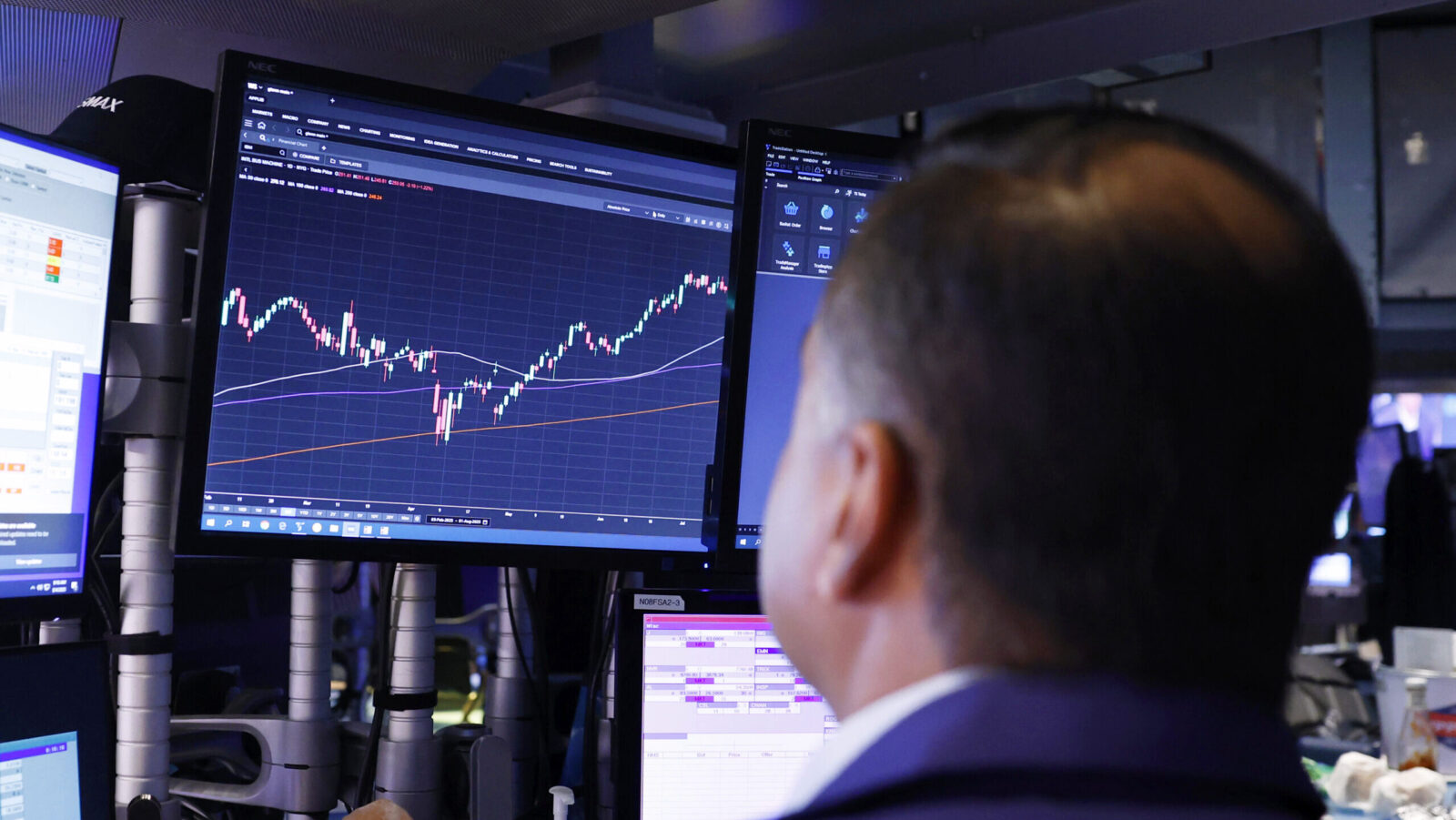Good morning, and happy Monday.
Ever wanted to sit courtside at an NBA game? Now’s your chance. At least, if you happen to be one of the few people who dished out $3,500-plus for an Apple Vision Pro headset.
Last week, the NBA and Apple announced that select Lakers games this season will be broadcast in an immersive new format that will allow users to view the game as if sitting courtside (or, alternatively, right under the basket). Sure, the 40-year-old Lebron James, who is about to play in a record 23rd NBA season, may only have four championship rings compared with Michael Jordan’s six. But even MJ stans must admit that a career spanning the days of 4:3 standard-definition televisions to the futuristic world of VR counts for something.
Trump’s New China Tariff Threat Halts Markets’ Optimistic ‘Melt-Up’

It feels like April in October, and not just because temperatures are back in the 60s in New York City. The trade war jitters that roiled Wall Street last spring are back.
US stocks closed down sharply on Friday after President Donald Trump renewed threats to impose a “massive increase” in tariffs on imports from China. After markets closed, he said the US would impose a levy on goods from the world’s second-largest economy, amounting to 100% “over and above any tariff that they are currently paying” starting November 1. It was a gut check at a time when analysts are increasingly worried about an unsustainable “melt-up” driven by AI enthusiasm.
Trading Places
Slowdowns in the US job market and manufacturing sector haven’t dented optimism about generative artificial intelligence, which has fueled the equities euphoria since the White House tariff shock in April. Describing America as “one big bet on AI,” Financial Times columnist Ruchir Sharma noted last week that 80% of gains in US stocks this year have come from AI companies. As of Friday, the S&P 500 was trading at roughly 9% above its 200-day moving average. That’s what has some commentators fearing a “melt-up,” where equity valuations are bolstered by investor optimism, herd mentality, and/or fear of missing out (FOMO) instead of economic fundamentals.
International Monetary Fund Managing Director Kristalina Georgieva invoked the dot-com bubble in a speech last week, stating that “valuations are heading towards levels we saw during the bullishness about the internet 25 years ago.” She added that global growth would be dragged down “if a sharp correction were to occur.” JPMorgan CEO Jamie Dimon told the BBC he’s “far more worried than others” about such a correction, believing it could materialize in six months to two years. “I would give it a higher probability than I think is probably priced in the market … if the market’s pricing in 10%, I would say it is more like 30%,” he said. Meanwhile, Trump’s threat to revive sky-high tariffs on China on Friday, which he blamed on Beijing expanding export controls on rare earth minerals critical to high-tech manufacturing, highlighted how quickly things can change:
- The S&P 500 closed down 2.7% for the day, the Nasdaq Composite dropped 3.5%, and the Dow Jones fell 1.9%. “We’d become quite accustomed to relatively quiescent markets with an upward bias, so it was quite shocking to see stocks in a quick freefall,” Interactive Brokers chief strategist Steve Sosnick wrote in a note to clients.
- In the spring, Trump imposed escalating tariffs on Chinese goods, peaking at 145%, while Beijing retaliated with a 125% duty on US goods. Battered markets recovered only after the two sides reached a detente, but now the relationship between the world’s two largest economies could be headed for the rocks once more.
High Growth Stop: Tech stocks, among the most vulnerable to souring US-China trade relations, led Friday’s sell-off. Nvidia fell 4.8%, Meta 3.8%, Amazon 5%, AMD 7.7%, and Tesla 5%.
Keep Your Retirement Right On Track

Successful investing — especially for retirement — involves more than making the right moves. It’s also about avoiding the wrong ones.
Fisher Investments can help you steer clear of common mistakes. Grab their guide, 13 Retirement Investment Blunders to Avoid, and learn ways to position a $1M+ portfolio for success.
Want a sneak peek? The guide highlights common investing mistakes, like being too conservative in investing, paying excessive fees and mismanaging withdrawals. Ready to enjoy the retirement you’ve saved for?
Dude, AI’s Getting a Dell (Server)
The rising AI tide continues to lift all tech boats. And we mean all tech boats, even somewhat forgotten giants like Dell.
Last week, shares of the personal computing company surged after executives doubled its long-term revenue and profit forecasts, thanks to its key and widening role in the AI infrastructure buildout. Which begs the question: Is Dell suddenly a growth stock?
Extreme AI Makeover
Dell’s AI transformation story is pretty simple: AI companies have an appetite for AI-powering servers that already exceeds $100 billion a year, according to Grand View Research, and Dell (which traditionally focused solely on PCs) is now a leading manufacturer of said servers. In its second-quarter earnings report, the company said sales in its servers and networking segment rose 69% from a year earlier, and it projects selling $20 billion worth of AI servers this year. Meanwhile, its old-school PC unit continues to generate steady cash flows, stabilizing the expensive and competitive server business.
It’s enough for the company to make significant changes to its long-term outlook:
- In its earnings call last week, Dell said it now expects annual revenue to grow between 7% and 9% long term, up from previous forecasts of 3% to 4%, and said earnings per share would grow at least 15%, up from earlier forecasts of just 8%.
- Shares of Dell spiked after the Tuesday earnings call, hitting an all-time intraday trading record on Wednesday. Dell climbed 3.4% last week, widening its growth so far this year to 30%.
“We were all wrong how big we thought the AI market was two years ago, and it’s nothing but bigger,” COO Jeff Clarke said ahead of the earnings call last week.
TikToking Clock: The AI pivot keeps Dell at the forefront of the tech industry and continues the winning streak for CEO and founder Michael Dell, who is estimated to be the 10th-richest person in the world by Bloomberg’s Billionaire Index. Last month, Dell, the person, scored another major win when he was named alongside Larry Ellison, Rupert Murdoch and Lachlan Murdoch as one of the US investors involved in the takeover of TikTok’s US operations. For his part, Dell seems to know the good times won’t last forever. In an interview on CNBC, Dell admitted that “at some point, there will be too many [data centers].” Add him to the list of mildly concerned bubble-watchers.
Cut Fees, Not Growth, With Smarter Global Payments. Stop wasting money on hidden bank fees and forced currency conversions. Access Airwallex and The Daily Upside’s on-demand webinar to learn how to open accounts in new markets, avoid recurring conversion costs, and capture growth opportunities with smarter payment strategies designed to keep more of your budget working for you. Access the webinar now.
DoorDash Doubles Down on Robot Couriers
Legendary sci-fi author Philip K. Dick once asked, “Do Androids Dream of Electric Sheep?” These days, the more pertinent question seems to be: Do robots dream of stealing a French fry?
Last week, DoorDash announced that it would team with Serve Robotics to add the company’s delivery robots to its fleet of food couriers, with robot delivery soon coming to LA.
At Your Service
You may have already noticed Serve’s delivery robots zipping around your city (or, at least, hanging around with celebrities on John Mulaney’s Netflix talk show). That’s because Serve robots are already hard at work in LA, Chicago, Dallas, Atlanta and Miami, operating as couriers for Uber Eats. That partnership followed Serve’s spin-off from the Uber-owned delivery service Postmates in 2021.
Its partnership with DoorDash is not exclusive, meaning both sides can continue to expand their robot operations apart from each other. It’s why robot-deliverers, like Waymos and robotaxis before them, may soon feel like an ubiquitous part of daily urban life:
- Serve said last week that it’s aiming to expand its US fleet to 2,000 robots by the end of the year. The company is not yet profitable, but CFO Brian Read has told Bloomberg that a bigger fleet can increase its revenue and operating leverage; shares of Serve climbed 8% last week.
- DoorDash, meanwhile, has already employed robot deliverers in LA and Chicago courtesy of rival firm CoCo Robotics. In September, the company also unveiled a fleet of robot deliverers developed in-house, which are designed to travel on bike paths and roads as well as sidewalks, and are capable of reaching speeds of up to 20 miles per hour.
Nice Gig: Serve’s robots, which operate primarily on sidewalks, will be capable of juggling orders from both DoorDash and Uber, just as regular human couriers work on multiple apps at once (robots … they’re just like us). So far, the company has said that its robot’s average delivery range is under a mile, with a time of under 18 minutes, making it a useful complement to human couriers who can handle longer and more complicated deliveries. Here’s a friendly reminder to tip your human couriers.
Extra Upside
- No Stopping Them: The US Bureau of Labor Statistics said it plans to publish the September consumer inflation data report on October 24, even if the government shutdown is ongoing.
- Motion Seconded: AstraZeneca became the second major multinational pharmaceutical company to strike a deal with the White House to lower drug prices in the US.
- Become A Wealthier Marketer For Free: Digital marketers making $50k/month read the Stacked Marketer newsletter daily. It delivers carefully curated digital marketing news, tactics and actionable advice. Subscribe for free.*
* Partner

